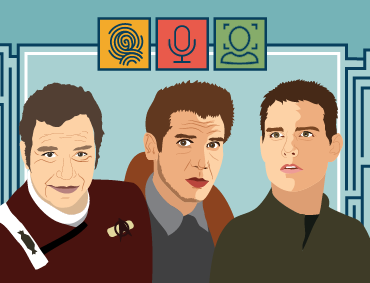Facial recognition used to just be for science fiction. Eye sensors and voice scanners used to only be something we’d see in the movies. But these biology-based security systems from science fiction are no longer just futuristic dreams. They are now the reality of maintaining security.
Let’s revisit some examples of biometrics in movies and television.
Paste this Image on Your Site!
Simply copy and paste the code below and you can share this infographic on your site:
Star Trek (1966-)
Voice ID: The ship could identify the speaker and was able to distinguish between conversations and voice commands.
Retina Scan: In “The Wrath of Khan,” Kirk uses a retina scan to access Project Genesis data.
Basic Vitals: The Tricorder is a handheld device that can scan for lifeforms and record technical data; a medical version could diagnose diseases and record body statistics.
Face Recognition: Face scans were used to enter the archives in “Star Trek Into Darkness.”
2001: A Space Odyssey (1968)
Voice Recognition and Face Recognition: In the 1960s, computers cost $5 million and had one-thousandth of today’s computing power. Yet the film’s creators envisioned computers that could authenticate by voice, understand speech and interpret emotions. HAL 9000 said: “I can tell from your voice harmonics, Dave, that you’re badly upset. Why don’t you take a stress pill and get some rest?”
Blade Runner (1982)
Eye Scan: The Voight-Kampff machine is a polygraph that measures the involuntary dilation of the iris to identify empathy and determine if the subject is human. Test questions include: (1) It’s your birthday and someone gives you a calfskin wallet. How do you react? (2) You’ve got a little boy. He shows you his butterfly collection plus the killing jar. What do you do? In real life, the Voight-Kampff test has been used in online dating and in political elections, presumably to test if the person is human.
RoboCop (1987)
Face Recognition: RoboCop uploads the image of a villain into the computer, which is able to identify the person using a photograph database. The cyborg’s face-scanning technology has been transformed into wearable tech applications for law enforcement.
Back to the Future 2 (1989)
Fingerprint ID: The movie’s predictions for 2015 included using fingerprints to unlock doors. McFly’s home has a scanner, not a doorknob. A frontpage newspaper headline read: “Thumb bandits” amputate digits to gain high-security access. Fingerprints were also used to validate digital payments. Biff uses his thumbprint to pay for a taxi.
The Fifth Element (1997)
Face Recognition: Police vehicles have face recognition software.
Species ID: Law enforcement uses scanners to detect species classification.
Gattaca (1997)
DNA ID: A genetic registry database is critical in a world of genetically selected humans and genetic discrimination. FBI agents, called “Hoovers,” use vacuum cleaners to gather DNA evidence. The main character’s identity is revealed when he accidently leaves an eyelash at a crime scene.
Alien: Resurrection (1997)
Breathprint: Breath recognition is used to gain security access.
Hand Scanner: To access restricted areas, Perez uses two-factor authentication via PIN code and handprint.
Starship Troopers (1997)
Brain Scan: Some citizens have psychic abilities, such as reading minds and even mind control. Brain Bugs could not only read minds but steal knowledge and memories from other beings.
Minority Report (2002)
Eye Scanner: A citywide optical recognition system identifies people, tracks their movements and transmits movement data to the police. Customized advertising is displayed based on identity. To avoid detection, Anderton gets an eye transplant from a black market doctor. He carries his original eyeballs in a plastic bag to maintain access to his former workplace. Yikes!
Terminator: Rise of the Machines (2003) and Terminator Renaissance (2009)
Retina Scan: Sent back in time to 2004, the T-X Terminatrix has a visual display that overlays computer identification and information about what it sees.
DNA ID: To identify a subject by DNA, the T-X sticks a finger in the blood, then on her tongue.
Face Scan: Skynet probes rely on facial recognition ID.
I, Robot (2004)
Voice ID: Used to gain file access.
Side of Palm: Lab security IDs people through the side of their closed fist.
Wall-E (2008)
Life Form Detection: EVE (which stands for Extraterrestrial Vegetation Evaluator) is a droid equipped with a scanner to detect self-sustaining plant life.
District 9 (2009)
DNA Authentication: Aliens’ weapons use a DNA-enabled trigger lock to prevent the guns from being used by another species.
Dredd (2012)
Voice Recognition and DNA Match: The “Lawgiver” is a semi- and fully automatic handgun with a maximum range of 3 miles. If an unauthorized person tries to use the gun, it will explode in their hand. It has an LED display screen that displays distance to target and remaining ammunition. Each round of ammo is tagged with the DNA of the gun’s owner.
Ex Machina (2015)
Face Recognition: His cell phone uses its camera to read Caleb’s facial expression as he is typing. The humanoid robot, Ava, also uses facial recognition.
Biometrics Totals
Listed in order of appearance, here are the total counts of the number of times each biometric was used in the movies.
- Voice ID: 5
- Retina scan:4
- Basic Vitals: 1
- Face Recognition: 6
- Fingerprint ID: 1
- Species ID: 1
- DNA ID: 4
- Breathprint: 1
- Hand Scan: 1
- Brain Scan: 1
- Side of Palm: 1
Fair Use
We enjoy seeing our infographics shared and just ask that you link back to Avatier as the source. Thanks!





